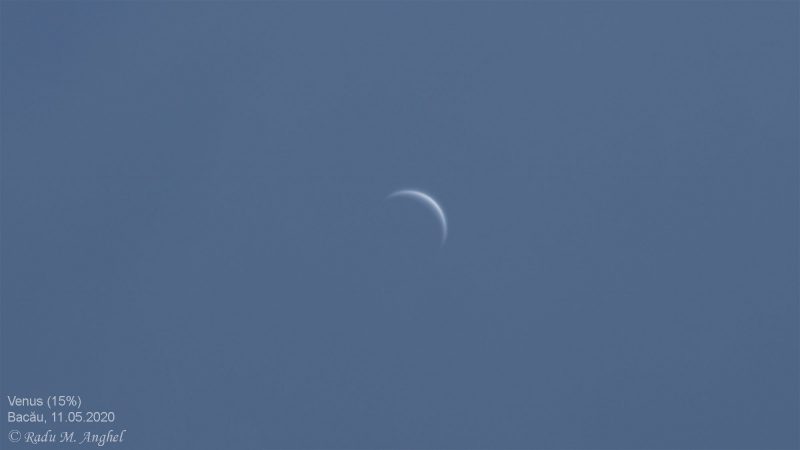
Venus brightest around December 3
Venus is the brightest planet. But it shines even more brightly than usual in late November and early December 2021. You can’t miss it if you look west after sunset on any clear evening around now. When it’s this bright, Venus appears as an eerily eye-catching beacon, low in the sky, near the sunset (as now) or sunrise (in early 2022). It’s visible in bright twilight only, blazing out from the pink sky. On December 3, Venus will reach its greatest illuminated extent. The lighted portion of the planet visible from Earth – the crescent Venus, seen through telescopes now – will cover its greatest area on our sky’s dome. So it’s around this time that astronomers will say Venus appears at greatest brilliancy.
Greatest brilliancy for Venus is a treat! Watch for Venus in the west after sunset in the coming days.
Venus’ reign in the evening sky started around May 2021, and will come to an end on January 9, 2022. That’s when Venus will pass between us and the sun, bringing it to the location in our sky that astronomers call inferior conjunction. In other words, between now and the end of this year, Venus will be sinking closer and closer to the sunset glare.
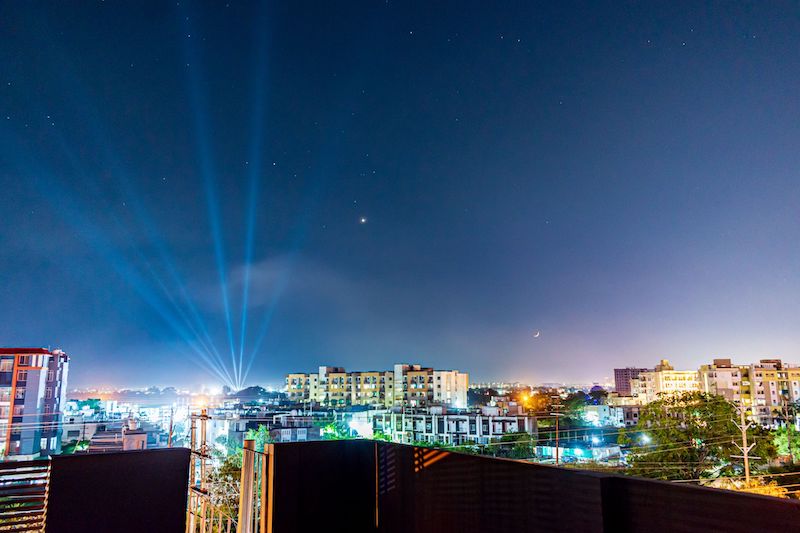
Why is Venus brightest?
Did you know that Venus shows phases, just as the moon does? But you’ll need a small telescope to view its changing phases.
Check out the diagram below to visualize Venus’ phases and its location relative to the sun and Earth. The planet appears smallest – covering the smallest area of sky – when Venus first enters the evening sky. That moment, just past superior conjunction, Venus is located at the far side of its orbit from us. It’s just peeking out after being behind or almost behind the sun as viewed from Earth. And its daylight side faces us. Superior conjunction last happened on March 26, 2021. It’ll happen next on October 22, 2022.
As Venus continues in its orbit after superior conjunction, the distance between Earth and Venus begins to decrease. Venus is pulling up behind Earth, on the inside track around the sun. The apparent disk of the planet grows larger but we see less of its daylight size. Through a telescope, we can see Venus wane in phase, going from gibbous, to half disk, and to a crescent.
Venus will then pass in front, or nearly in front, of the sun at inferior conjunction. That’s the event coming up next, on January 9, 2022. At inferior conjunction – when Venus is passing between us and the sun, the planet’s night side is facing Earth’s direction. We can’t see Venus, in part because its day side is facing away from us and in part because the planet is traveling with the sun across the sky throughout the day. At inferior conjunction, Venus is lost in the sun’s glare.
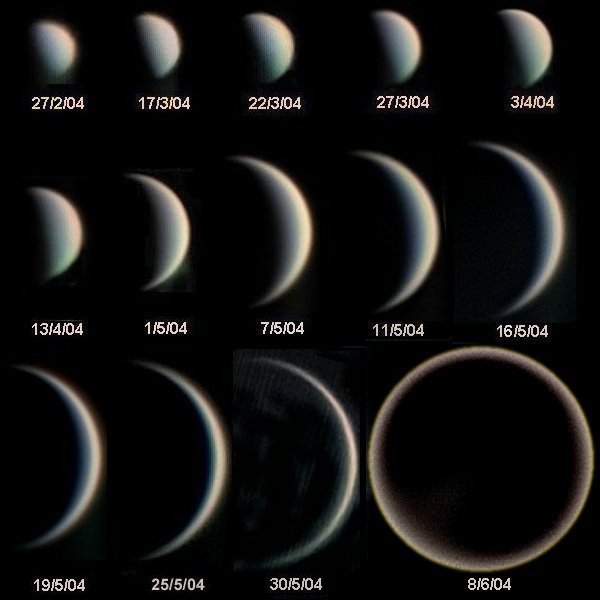
Venus brightest at a crescent phase
It might surprise you to learn that Venus shines most brightly in our sky when displaying a crescent phase, approximately 25% illuminated. Venus’ greatest illuminated extent is when the lit part of the planet covers the largest area on the sky. For Venus, that moment occurs during its crescent phase, and that’s around when it appears brightest to us.
In the diagram below, note two points in Venus’ orbit called greatest elongation. That’s when the angle between Earth, Venus, and the sun is 90 degrees. It’s also when Venus appears at its highest, greatest distance from the sun on our sky’s dome. Around greatest elongation, we see Venus as approximately 50% illuminated, a half-Venus.
Why did we ask you to take note of the greatest elongations? Because Venus’ greatest illuminated extent in the evening sky – happening in early December – always happens about a month after Venus reaches greatest eastern elongation. The last eastern elongation happened on October 29, 2021. Venus is brightest, at greatest illuminated extent, on December 3. After greatest illuminated extent, about another month will pass before Venus sweeps to inferior conjunction, this time on January 9, 2022. It’s on January 9 that Venus will officially leave our evening sky, and enter our morning sky. Shortly after January 9, you’ll begin to see Venus in the east before sunrise.
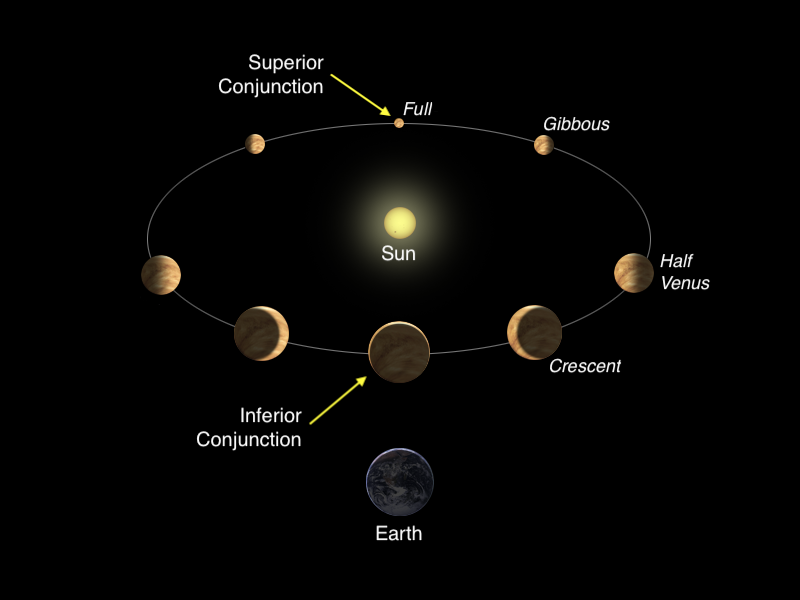
Another greatest brilliancy for Venus
And perhaps it’ll come as no surprise that Venus will have a greatest illuminated extent in the morning sky too. After all, as it speeds ahead of Earth in orbit, its phase will be increasing. About a month after inferior conjunction – on February 9, 2022, just over a month after the January 9 inferior conjunction – Venus will once more be at greatest illuminated extent and at its brightest in the morning sky. That’ll be just over a month before Venus will reach greatest western elongation – its greatest distance from the sunrise – on March 20, 2022.
Isn’t it great how orderly the heavens are? Enjoy Venus at its brightest! It’s a sight to see.
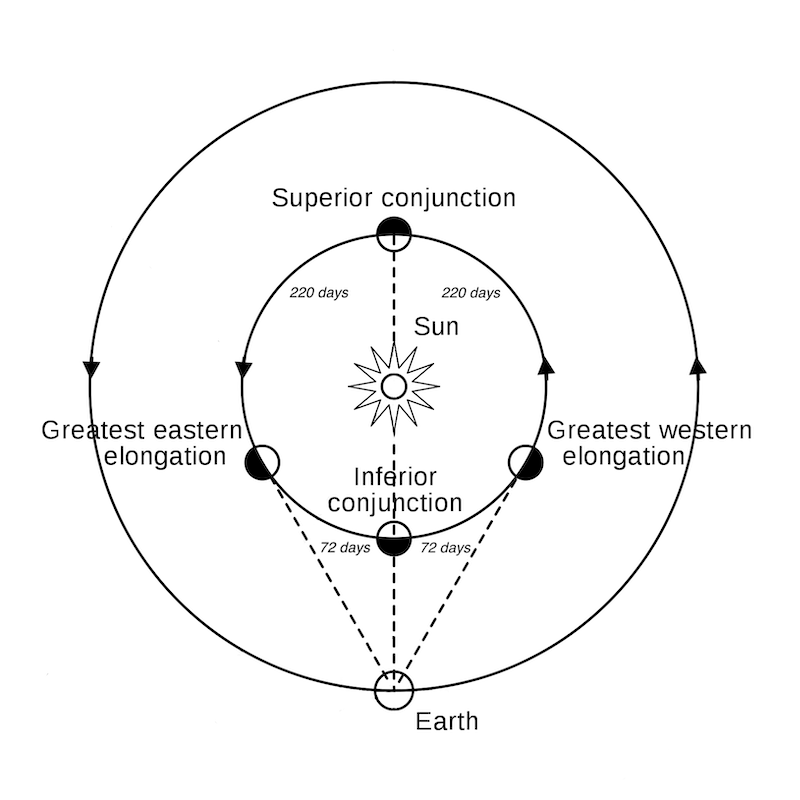
Bottom line: Venus will appear at its brightest in the few weeks centered on two dates, December 3, 2021, and February 9, 2022.
Planet-observing is easy: Top tips here
EarthSky’s monthly planet guide: Visible planets and more
The post Venus brightest for 2021 around December 3 first appeared on EarthSky.
from EarthSky https://ift.tt/3l4QYCo

Venus brightest around December 3
Venus is the brightest planet. But it shines even more brightly than usual in late November and early December 2021. You can’t miss it if you look west after sunset on any clear evening around now. When it’s this bright, Venus appears as an eerily eye-catching beacon, low in the sky, near the sunset (as now) or sunrise (in early 2022). It’s visible in bright twilight only, blazing out from the pink sky. On December 3, Venus will reach its greatest illuminated extent. The lighted portion of the planet visible from Earth – the crescent Venus, seen through telescopes now – will cover its greatest area on our sky’s dome. So it’s around this time that astronomers will say Venus appears at greatest brilliancy.
Greatest brilliancy for Venus is a treat! Watch for Venus in the west after sunset in the coming days.
Venus’ reign in the evening sky started around May 2021, and will come to an end on January 9, 2022. That’s when Venus will pass between us and the sun, bringing it to the location in our sky that astronomers call inferior conjunction. In other words, between now and the end of this year, Venus will be sinking closer and closer to the sunset glare.

Why is Venus brightest?
Did you know that Venus shows phases, just as the moon does? But you’ll need a small telescope to view its changing phases.
Check out the diagram below to visualize Venus’ phases and its location relative to the sun and Earth. The planet appears smallest – covering the smallest area of sky – when Venus first enters the evening sky. That moment, just past superior conjunction, Venus is located at the far side of its orbit from us. It’s just peeking out after being behind or almost behind the sun as viewed from Earth. And its daylight side faces us. Superior conjunction last happened on March 26, 2021. It’ll happen next on October 22, 2022.
As Venus continues in its orbit after superior conjunction, the distance between Earth and Venus begins to decrease. Venus is pulling up behind Earth, on the inside track around the sun. The apparent disk of the planet grows larger but we see less of its daylight size. Through a telescope, we can see Venus wane in phase, going from gibbous, to half disk, and to a crescent.
Venus will then pass in front, or nearly in front, of the sun at inferior conjunction. That’s the event coming up next, on January 9, 2022. At inferior conjunction – when Venus is passing between us and the sun, the planet’s night side is facing Earth’s direction. We can’t see Venus, in part because its day side is facing away from us and in part because the planet is traveling with the sun across the sky throughout the day. At inferior conjunction, Venus is lost in the sun’s glare.

Venus brightest at a crescent phase
It might surprise you to learn that Venus shines most brightly in our sky when displaying a crescent phase, approximately 25% illuminated. Venus’ greatest illuminated extent is when the lit part of the planet covers the largest area on the sky. For Venus, that moment occurs during its crescent phase, and that’s around when it appears brightest to us.
In the diagram below, note two points in Venus’ orbit called greatest elongation. That’s when the angle between Earth, Venus, and the sun is 90 degrees. It’s also when Venus appears at its highest, greatest distance from the sun on our sky’s dome. Around greatest elongation, we see Venus as approximately 50% illuminated, a half-Venus.
Why did we ask you to take note of the greatest elongations? Because Venus’ greatest illuminated extent in the evening sky – happening in early December – always happens about a month after Venus reaches greatest eastern elongation. The last eastern elongation happened on October 29, 2021. Venus is brightest, at greatest illuminated extent, on December 3. After greatest illuminated extent, about another month will pass before Venus sweeps to inferior conjunction, this time on January 9, 2022. It’s on January 9 that Venus will officially leave our evening sky, and enter our morning sky. Shortly after January 9, you’ll begin to see Venus in the east before sunrise.

Another greatest brilliancy for Venus
And perhaps it’ll come as no surprise that Venus will have a greatest illuminated extent in the morning sky too. After all, as it speeds ahead of Earth in orbit, its phase will be increasing. About a month after inferior conjunction – on February 9, 2022, just over a month after the January 9 inferior conjunction – Venus will once more be at greatest illuminated extent and at its brightest in the morning sky. That’ll be just over a month before Venus will reach greatest western elongation – its greatest distance from the sunrise – on March 20, 2022.
Isn’t it great how orderly the heavens are? Enjoy Venus at its brightest! It’s a sight to see.

Bottom line: Venus will appear at its brightest in the few weeks centered on two dates, December 3, 2021, and February 9, 2022.
Planet-observing is easy: Top tips here
EarthSky’s monthly planet guide: Visible planets and more
The post Venus brightest for 2021 around December 3 first appeared on EarthSky.
from EarthSky https://ift.tt/3l4QYCo

Aucun commentaire:
Enregistrer un commentaire